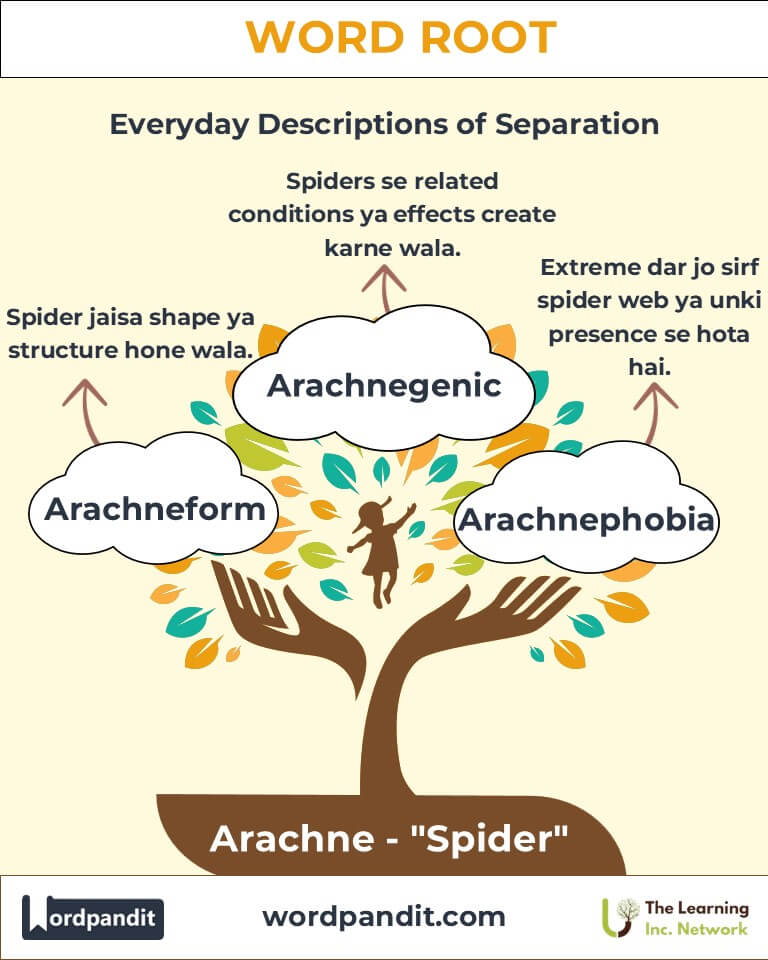Arachn: Exploring the Web of Words Spun by "Spider"
Discover the fascinating world of the root "arachn," derived from the Greek word for "spider." Found in terms as diverse as "arachnid" and "arachnophobia," this root captures the essence of the intricate and the eerie. From biology to mythology, arachn has woven itself into language and culture.

Table of Contents
- Introduction: The World of Arachn
- Etymology and Historical Journey
- Mnemonic: Remembering Arachn
- Common Arachn-Related Terms
- Arachn Through Time
- Arachn in Specialized Fields
- Illustrative Story: Arachn in Action
- Cultural Significance of Arachn
- The Arachn Family Tree
- FAQs about the Arachn Word Root
- Test Your Knowledge: Arachn Word Root Quiz
- Conclusion: Arachn's Lingering Legacy
Introduction: The World of Arachn
Arachn (pronounced uh-RAK-n) is a root derived from the Greek word aráchnē, meaning "spider." It has crept into words that describe the intricate, the fearful, and the biological. From the scientific study of arachnids to the fear of spiders, this root weaves a web of fascinating applications. But its significance extends beyond biology—it’s rooted in myth, psychology, and even art.

Etymology and Historical Journey
The word root arachn finds its origins in Greek mythology, where Arachne, a mortal woman, was transformed into a spider by the goddess Athena after a weaving contest. Her name became synonymous with spiders and their intricate webs. The root later made its way into scientific terminology, used to classify arachnids—creatures like spiders, scorpions, and ticks.
Mnemonic: Remembering Arachn
Imagine a spider spinning an intricate web in the corner of a room, each strand representing a word derived from arachn. The spider symbolizes how the root connects concepts of intricacy and fear.
Mnemonic Device: "A spider’s arachn-ing web reminds us of its linguistic threads in words like arachnid and arachnophobia."
Common Arachn-Related Terms
- Arachnid (uh-RAK-nid)
- Definition: Any member of the class of joint-legged invertebrates that includes spiders, scorpions, and ticks.
- Example: "The black widow is a venomous arachnid."
- Arachnophobia (uh-rak-NO-foh-bee-uh)
- Definition: An intense fear of spiders.
- Example: "Her arachnophobia made camping in the woods a challenge."
- Arachnology (uh-rak-NOL-uh-jee)
- Definition: The scientific study of spiders and related creatures.
- Example: "Arachnology reveals the ecological importance of spiders."
- Arachnitis (uh-rak-NY-tis)
- Definition: Inflammation of the arachnoid membrane of the brain or spinal cord.
- Example: "The condition was diagnosed as arachnitis, requiring immediate attention."
Arachn Through Time
- Mythological Origins:
- In Greek mythology, Arachne’s transformation into a spider symbolized hubris and divine retribution.
- Her story established the spider as a symbol of artistry and cautionary tales.
- Scientific Evolution:
- The term "arachnid" was formalized in the 19th century, encompassing creatures that share a similar body structure to spiders.
Arachn in Specialized Fields
- Biology:
- Arachnid refers to a diverse group of joint-legged invertebrates.
- Relevance: These creatures play crucial roles in ecosystems, from pest control to pollination.
- Psychology:
- Arachnophobia is one of the most common specific phobias.
- Application: Treatments like exposure therapy help individuals manage this fear.
- Neurology:
- The Arachnoid Membrane covers the brain and spinal cord, and conditions like arachnitis affect it.
- Importance: Understanding these terms aids in diagnosing neurological issues.
Illustrative Story: Arachn in Action
Lila, a budding scientist, was terrified of spiders. Yet, her fascination with their webs led her to study arachnology. While researching in a rainforest, she encountered a golden orb-weaver spider spinning a shimmering web. Over time, her curiosity outweighed her arachnophobia, and she became an advocate for spider conservation, recognizing their ecological importance.
Cultural Significance of Arachn
Spiders have been revered and feared in cultures worldwide. From the myth of Arachne to Anansi, the spider trickster in African folklore, they symbolize creation, cunning, and complexity. Today, they inspire art, technology (like biomimetic spider silk), and even fashion.

The Arachn Family Tree
- Insect- (Latin: "cut into")
- Example: Insecticide – Substance used to kill insects.
- Zoo- (Greek: "animal")
- Example: Zoology – The study of animals.
- Phobia- (Greek: "fear")
- Example: Claustrophobia – Fear of confined spaces.

FAQs About " Arachn "
Q: What does "arachn" mean?
A: "Arachn" means "spider" and is derived from the Greek word aráchnē. It often relates to spiders and their characteristics, such as their web-spinning abilities or fear associated with them.
Q: Are all arachnids spiders?
A: No, spiders are just one type of arachnid. The class Arachnida includes other creatures like scorpions, ticks, and mites, all of which share characteristics such as jointed legs and a two-part body structure.
Q: What is arachnophobia?
A: Arachnophobia is an intense and irrational fear of spiders. It is one of the most common specific phobias and may stem from evolutionary survival instincts, cultural influences, or past traumatic encounters.
Q: How is arachnology important?
A: Arachnology is the scientific study of spiders and related creatures. It provides valuable insights into biodiversity, pest control, and ecological balance. Spiders, for instance, play a critical role in controlling insect populations.
Q: What is the origin of the root "arachn"?
A: The root "arachn" originates from the Greek myth of Arachne, a skilled mortal weaver who challenged the goddess Athena to a weaving contest. After losing, Arachne was turned into a spider, forever weaving webs.
Q: Why are spiders often feared in different cultures?
A: Fear of spiders may be evolutionary, as some spider species are venomous. Additionally, their sudden movements, web entanglements, and association with dark or hidden places contribute to their fearful reputation.
Q: What is the difference between arachnids and insects?
A: Arachnids, like spiders, scorpions, and ticks, have two body segments and eight legs. Insects, such as butterflies and ants, have three body segments, six legs, and often wings.
Test Your Knowledge: " Arachn " Mastery Quiz
1. What does the root "arachn" signify?
2. Which of the following is NOT an arachnid?
3. What is arachnology?
4. Which Greek myth inspired the root "arachn"?
5. What does arachnophobia describe?
Conclusion: Arachn's Lingering Legacy
The root arachn connects us to the spider’s world of intricacy, beauty, and fear. Whether in mythology, biology, or psychology, this root underscores the impact of these creatures on human imagination and language. As science and culture evolve, arachn continues to weave its web across diverse fields, reminding us of the complexity of the natural world.












